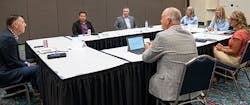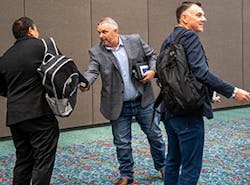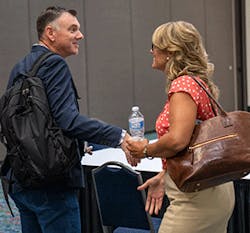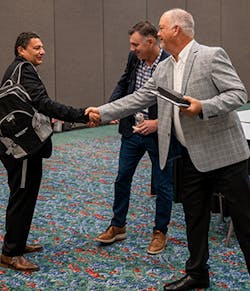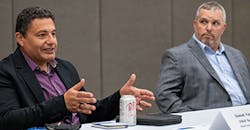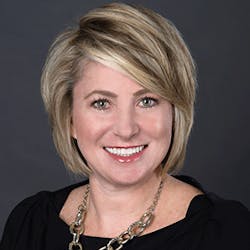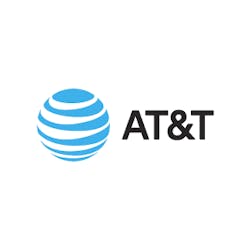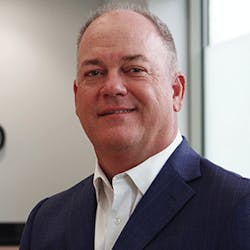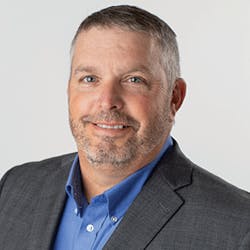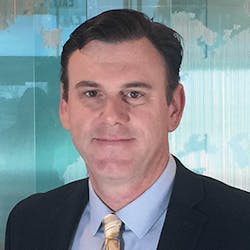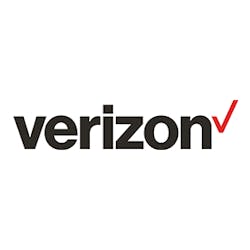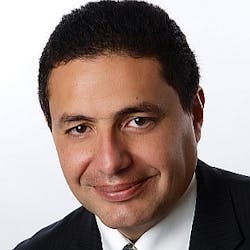2021 ICT Visionaries Roundtable Highlights
Transformative thinking doesn’t occur in a vacuum. That’s why we invited our 2021 ICT Visionaries to a live roundtable discussion during ISE EXPO 2021. While some were unable to attend due to the obvious reasons, others were eager to talk candidly about the challenges they’ve faced recently, and a few solutions from which their fellow Visionaries could benefit. Read the insights they agreed to share.
These are the questions that were asked. Scroll down to read the responses.
Topic: Are Top Trends Your Reality?
In your opinion, what are the top 2 trends providers and vendors should address ASAP? Why?
Middle: Jason Atwater, CTC
Right: Dave Cooper, Lumen
Topic: Network Reliability
What is the Achilles’ heel for network reliability as network demands continue to increase? How can providers better manage the network life cycle of complex 5G and Fiber networks?
Topic: Cultural Transformation
Explain why cultural transformation is as important as technical transformation to ensure that Communications Service Providers thrive in the future.
Topic: Labor Challenges
The US telecommunications industry employs a total of 672,000 workers, with average annual wages of $77,500. It’s forecasted that 5G rollout and other technologies could create 850,000 more "new direct broadband and 5G jobs" through 2025. Executives in the US telecom network construction sector have been arguing that they’re having difficulties finding enough skilled workers to deploy fiber and 5G networks. The CWA, who represents 700K workers in the telecom industry, says that may not be the case. What are your thoughts about this?
Right: Tammy Perry, Horizon
Topic: Corporate Empathy
Now, more than ever, customers are looking for insights into the kinds of companies they can trust. Companies that fail to take the right steps in showing thoughtfulness and empathy could lose their customer base forever. What is your company doing to walk its talk to both customers and employees?
Topic: My Take
Share one problem/challenge you are passionate about solving for the ICT Industry.
Middle: Dave Cooper, Lumen
Right: Kevin Morgan, Clearfield
Topic: Hybrid Networks
If we want to close the Digital Divide, upgrade broadband speeds, and reduce latency for end users, hybrid networks may be the answer. However, many challenges arise using hybrid strategies. In your opinion, what are some of the most daunting network-related challenges for providers as they work to scale hybrid networks? While cost is the most obvious, what other things get in the way? How can they be remedied?
Topic: Electric Utility Cooperatives Collaboration
From a Fiber-to-the-Home (FTTH) perspective, the Rural Development Opportunity Fund (RDOF) auction was all about Rural Electric Coops (RECs) getting into the fiber business. In fact, 199 cooperatives (almost 25% of the total RECs) qualified to bid in the auction. Over half of them (125) were successful, winning almost 1 million locations. Share 1-2 best practices RECs can learn from telecom service providers in terms of fiber deployments. What is one thing they should avoid?
Right: Kevin Morgan, Clearfield
Topic: Automation, Intelligence, and OpEx
IoT, AR, and mixed realities, could combine with 5G technology, allowing engineers to see equipment through a headset and make changes to performance — all by tapping buttons on a keyboard that send instructions to connected devices. Are these things the secret sauce to reduce OpEx? If not, what is?
Topic: Chip Supply Constraints
Reports from several telecom associations share their worries about supply constraints. Some argue the large carriers have been insulated from the adverse effects of supply shortages due to their bargaining power.
However, the NCTA warns the impacts have been "substantial and widespread." Its members reported lead times for semiconductors have skyrocketed from approximately 18 weeks in early 2020 to "50 weeks or more today." NCTA also shared that some broadband providers have been forced to "limit efforts to expand coverage to new areas" resulting from these lead times.
Right: Jason Atwater, CTC
TIA also warned of "ripple effects" from the shortage which "are harming efforts to bridge the digital divide and expand access to high-speed Internet to underserved communities, including communities of color and other economically distressed areas."
Share your thoughts about these shortages. Do you believe they have created a catch-22 for network providers keen to accelerate planning and deployment to take advantage of recent broadband network funding?
Kelly Thengvall
Assistant Vice President – Customer Care
AT&T
Topic: Corporate Empathy
To put it simply, we are listening to our customers and employees. By listening to them, we’re able to make actionable changes that not only show we understand their desires, but that demonstrate how much we value their thoughts and appreciate their willingness to share as well. More specifically, our customers know exactly what they need in order to have a more positive experience with our company, and, in turn, they share those thoughts with our employees. So by prioritizing connection with our teams, we are ultimately able to connect with our customers on a deeper level as well. When we do that, we have a better chance of living up to our internal and external commitments.
Similarly, empathy must be present and integrated into all communications and customer touchpoints. That can seem like a big task but when every employee leads with the age-old saying Treat others the way you would want to be treated, empathy becomes less of a task and more of an embedded company trait that allows us to again, connect with both our customers and fellow employees in more meaningful ways. That connection is what resonates with people and builds the trust that so many are looking for in the brands they choose to do business with.
Topic: Cultural Transformation
A technical transformation results in the updated tools and technologies teams need to succeed, which is absolutely important. That transformation is critical in making work easier and more efficient for employees. However, without a cultural transformation, there is no purpose. Your teams may not have the drive and ambition to work toward a larger goal. That lack of purpose and commonality can then result in a disjointed customer experience — a factor that Communications Service Providers can no longer afford to have.
That’s why at AT&T, we have 4 pillars that make up our culture. Whether you are working as a Senior Vice President or as a customer-facing Team Member, we all strive to: Serve Customers First, Move Faster, Act Boldly, and Win as One. By doing this, we show up to work for the same purpose, work toward the same common objectives, and strive to deliver one, cohesive experience for both our customers and employees.
Kelly Thengvall, Assistant Vice President (AVP) of Customer Care, AT&T Consumer, leads a passionate team of over 3,000 people dedicated to improving customer experiences through back-office functions supporting Legacy Customer Care and Order Completion Management. Her ability to collaborate across the business helps the team resolve root cause customer pain points through technology, automation and process enhancements. Since her role as an AT&T Service Representative, Kelly has dedicated herself to empathizing with customers and made meaningful contributions by simplifying operations and processes so customers are served more efficiently.
AT&T is a diversified, global leader in telecommunications, media and entertainment, and technology. AT&T Communications provides more than 100 million U.S. consumers with entertainment and communications experiences across TV, mobile and broadband. Plus, it serves high-speed, highly secure connectivity and smart solutions to nearly 3 million business customers.
WarnerMedia is a leading media and entertainment company that creates and distributes premium and popular content to global audiences through its consumer brands, including: HBO, HBO Max, Warner Bros., TNT, TBS, truTV, CNN, DC Entertainment, New Line, Cartoon Network, Adult Swim and Turner Classic Movies. Xandr, now part of WarnerMedia, provides marketers with innovative and relevant advertising solutions for consumers around premium video content and digital advertising through its platform. AT&T Latin America provides pay-TV services across 10 countries and territories in Latin America and the Caribbean and wireless services to consumers and businesses in Mexico. www.att.com
Kevin Morgan
Chief Marketing Officer
Clearfield
Topic: Hybrid Networks
Hybrid networks involve getting fiber deployed a little further into the network and then handing off to (typically) a wireless technology for customer connections. The network protocols (2G/3G/4G/5G) are constantly in flux, and spectrum use of airwaves are constantly changing. Each change in frequency band drives changing out CPE to capitalize on better broadband. WISPs have experienced this for years and are tired of it. Hybrid networks are a temporary fix to a long-term problem. The ultimate network will be fiber-based. Why not implement tomorrow’s networks today using today’s labor rate? Otherwise, economics says delaying will be even more expensive.
Topic: Electric Utility Cooperatives Collaboration
Users can purchase the system fully loaded or use the grow-as-you-go approach, in which building blocks like the Clearfield Clearview cassette are added as the number of homes served increases or take rates improve. Costs are contained because only the essential protection elements are added based upon the environment served. Things to avoid?
- Too little fiber deployed
- Announcing too early
- Understaffing Customer Service for a commercial BB Internet service.
We never hear providers say, "I put in too much fiber." Add more than you think you need. Fiber cable is not the costly portion of the build; the construction and labor costs typically account for 70% of the build. So, don’t skimp on the number of fibers deployed.
Kevin leads the marketing efforts for Clearfield as Chief Marketing Officer and joined the company in 2016 leveraging his extensive experience in advanced communications technology, fiber optic systems, and business product marketing. Prior to joining Clearfield, he spent two decades serving in various senior marketing positions at ADTRAN. Before that, he spent a decade at telephone operating company BellSouth, now a part of AT&T, where he worked as the lead broadband product evaluations resource in the Science & Technology department. Morgan also served in various leadership positions at the Fiber Broadband Association, and is currently Vice Chair of the Board of Directors for 2021.
For more information, please email [email protected]. Follow Kevin on Twitter @kevinmorgan520 and LinkedIn @kevinmorgan1.
When it comes to distribution, consolidation, management and protection of fiber, nothing comes close to Clearfield’s stream-lined, practical approach. Designed for scalable deployment, craft-friendly operation, and unsurpassed performance, Clearfield’s line of panels, frames, active and passive cabinets, optical components and full range of fiber optic assemblies and patch cords, are designed with the simplicity in design that delivers lowest total cost of ownership.
Clearfield’s FieldShield® fiber delivery system delivers a simple, fast fiber pathway through all points of the network to provide a total end-to-end solution. Combined with FieldShield last mile drop technologies the provider saves time and money with labor lite designs that reduce labor and skill at installation and at the pre-engineering stage.
Whether you’re delivering fiber to the business, home, or cell site, Clearfield has the flexibility and exceptional lead times to expedite and deploy the product platform for your entire range of applications. Follow Clearfield on Twitter @clearfieldfiber. www.SeeClearfield.com
Jason Atwater
Director of Network Operations
CTC
Topic: Cultural Transformation
If the past 18 months haven’t proven that cultural transformation is equally important to technical transformation, I don’t know what will. At CTC, we’ve tried to embrace the changes as best we can – whether they were adjustments we initiated or ones that were out of our control. We have staff working from home, we have flexible schedules, we talk about mental health, we know each other’s pets’ names… and these are just a few examples of how we’re intentionally fostering a culture that embraces productivity, promotes teamwork, and celebrates employees. The fact that we have an internal Employee Experience Team speaks volumes.
When I started at CTC 20+ years ago, the term workplace culture didn’t even exist. We went to work, we did our job, we went home. Part of the shift has been intentional, and some is due to the larger workplace trends and generational differences. The lines between personal and professional life have become a little blurry but in the long run, does it matter? We work hard, we get things done, and we try to have fun while doing it. I am fortunate to work alongside the best people in the business at CTC, and embrace the dynamic shift in both our member and employee experience!
Topic: Electric Utility Cooperatives Collaboration
RECs have an incredible opportunity when it comes to fiber deployment. It can be a win-win for many entities and, most importantly, for their members. At CTC we have partnered with RECs for nearly 10 years in order to bring FTTH deployments to unserved areas across the regions we serve.
We took things slow at first, making sure to provide the help they needed (i.e., back-end support, billing, network infrastructure, engineering, construction management, marketing, etc.) but at a level that fit with their pace, staff capacity, and member demand. If RECs rush into the fiber business, they may run into pretty significant service and churn issues. Taking it one step at a time with clear, honest, and open, communication procedures that defined the process and workload have helped to make our partnerships more successful.
One thing they should avoid: trying to be everything to everyone. Any business – including RECs – need to be realistic about what their strengths are and where they need to rely on vendors, partners, or outside consultants. Whether they partner with a telecom or not, it’s crucial that they set themselves up for success because getting into those unserved areas is what’s most important.
Jason Atwater holds the position of Director of Network Operations at CTC, a telecommunications cooperative based in Brainerd, Minnesota. He has 24 years of industry experience that includes 22 years with CTC in an operational and executive management role. Atwater graduated from Inver Hills College with a Telecommunications Degree, and from Dakota County Technical School with a Telecommunications Diploma. He has extensive knowledge and experience in network operations management, network planning, and partner relations — all with a member-centric vision. Previous positions with CTC include Operations Manager and Product Manager.
CTC is a technology advisor and full-service telecommunications cooperative based in Brainerd, Minn. Formed in 1952, CTC has grown into a complete communications provider offering high-speed Internet, digital television, phone, and IT services to businesses and residents throughout central and northern Minnesota.
As an advisor, CTC also partners with electric cooperatives, municipalities, and communities throughout the nation to bring in-demand services to rural homes and businesses. By assisting with system infrastructure, offering technical expertise, or securing funding for broadband, CTC helps organizations and entire towns build and maintain state-of-the-art fiber and wireless networks. Follow CTC on Twitter @ConnectCTC. You can also follow CTC on Facebook, LinkedIn, and Instagram. www.goctc.com
Tammy Perry
Director of FTTP Program Management
Horizon
Topic: Labor Challenges
This is a fast-paced industry with cutthroat expectations. Finding the people with the right DNA and skill set is a challenge. Flexibility and creativity are key to finding and keeping talent. Horizon is partnering with leaders in Ohio to establish a new broadband training program at a local career center to develop a talent pool with technical skills. We’re adapting our policies to include additional flexibility, added benefits, and a strong positive corporate culture, which will make our organization one people want to join and stay with for a long time.
Topic: Chip Supply Constraints
Strategic future planning and project management have never been more important. Business models and project plans should account for higher costs and longer lead times on everything from electronics to cabinets, fiber, strand, pedestals, closers . . . everything. The just-in-time supply chain model does not allow for supply chain disruptions, and we need to be getting away from that.
In order to be successful, providers should be looking years ahead and sourcing materials now. Partnerships with suppliers and accurately forecasting needs for allocation in advance of deployment timelines will help with suppliers, and accurately forecasting needs for allocation in advance of deployment timelines will help mitigate the risk of delays. Providers also need to be open to alternatives. In order to continue building, we might have to use products and deploy methods we haven’t used in the past.
Tammy Perry is a driven, obstacle-removing, change leader with a demonstrated history of turning chaos into trackable order. In her current role as the Director of Service Delivery at Horizon, she has proven inventive and motivational leadership to help drive employee and team performance to accomplish the unexpected. A dauntless, caffeinated, ENTJ, Tammy loves working outside her comfort zone and helping others to do the same. Outside of office hours she enjoys travel, camping, and entertaining family and friends. Follow her on LinkedIn @tammy-perry-b9a62a8
Horizon is a facilities-based, fiber optic broadband service provider based in Ohio, with expanding services across the Midwest. We provide high-quality connectivity solutions for small to large enterprise and wholesale carrier customers, where high-reliability and high availability are critical.
Horizon owns and operates over 4,500 route miles of fiber along with over-the-top services that are backed by local leadership, sales, customer care, and network operations. We offer robust and extensive connectivity solutions such as high-speed Ethernet, DIA and cloud-based Hosted Voice, along with dark fiber and wavelength services and connectivity into data centers across the Midwest.
With a drive for innovation and growth, Horizon has built up a state-of-the-art fiber infrastructure, all while maintaining the long-standing reputation for putting customer service first with unmatched responsiveness and care. At Horizon, we make business personal. Follow Horizon on Facebook, LinkedIn, and Twitter. www.horizonconnects.com
Dave Cooper
VP, Edge Compute, CDN & VyVx
Lumen
Topic: Cultural Transformation
Technology has always been a cornerstone to the success of Communications Service Providers (CSPs). Through the decades, we’ve depended on technology innovation to evolve our networks to support the hyper-growth demands of today’s digital economy. And as the last decade has shown, software has played a central role in the disruption of industries and creation of new growth opportunities. Software has been the proven enabler to digital transformation; creating opportunities to differentiate amongst competitors, improve the customer experience, and revolutionize the delivery of products and services in ways we’ve never seen.
But as excellence in software can be viewed as a key technology enabler, culture should be viewed as software’s enabler. Culture — the way in which we lead, organize, collaborate, scale, and innovate — can be a force multiplier towards software excellence. Or it can be the primary reason for failure.
The Communication’s industry has been going through its own digital disruption for some time. And, while many CSPs have embraced the role of software to navigate this shifting landscape, culture must play a foundational role. It must be first and foremost in the transformational process, and it must be company wide.
Topic: Network Reliability
Enterprises have long sought to address their network reliability requirements using diverse providers and technologies, balancing the cost of deployment and maintenance with the implied improvement in network uptime. With the growth in fiber providers throughout the US, I’ve seen firsthand where such a strategy can achieve these desired results, but I’ve also observed many complications and pitfalls in attempts to execute on such strategies.
The use of diverse providers and technologies requires an intense amount of collaboration within each provider, between providers and with customers to ensure that fiber routes, broadband, LTE/5G routes, meet the diversification requirements intended. That collaboration must be a continuous cycle, being audited to prevent grooms and moves from changing the diversification design. Further, many of the alternatives to fiber (broadband, LTE/5G) rely on fiber at some point in the network and should be fully understood in the total design. Providers can take additional steps to improve network reliability by continuing to advance the accuracy of inventory systems (network as the inventory) and use of locating technology to better prevent avoidable outages.
Dave has overall responsibility and general management of Lumen’s Edge Compute Program. Additionally, Dave has responsibility for Lumen’s Content Delivery Network and Vyvx architecture, engineering and software development. Previously, Dave served as CenturyLink’s VP Global Network Architecture overseeing all network technology deployed across the company’s global network.
Dave has 24 years of experience in designing, building and maintaining large-scale network and data-center architectures. He has spent the last decade leading network and software teams in progressing network automation and orchestration at scale. He has contributed to the development of numerous protocols and technologies including MPLS, Traffic-Engineering, Ethernet Pseuedowires and has numerous patents and patents pending in the areas of IP, Optical and Voice networks.
Lumen is guided by our belief that humanity is at its best when technology advances the way we live and work. With approximately 450,000 route fiber miles and serving customers in more than 60 countries, we deliver the fastest, most secure platform for applications and data to help businesses, government and communities deliver amazing experiences.
Learn more about Lumen’s network, edge cloud, security, communication and collaboration solutions and our purpose to further human progress through technology at news.lumen.com, LinkedIn: /lumentechnologies, Twitter: @lumentechco, Facebook: /lumentechnologies, Instagram: @lumentechnologies and YouTube: /lumentechnologies. Lumen and Lumen Technologies are registered trademarks of Lumen Technologies, LLC in the United States. Lumen Technologies, LLC is a wholly-owned affiliate of CenturyLink, Inc. www.lumen.com
Mattias Fridström
Chief Evangelist
Telia Carrier
Topic: Network Reliability
A correct and up-to-date inventory system remains the real Achilles’ heel for most service providers. Many service provider’s networks are an amalgamation of other service provider networks acquired over time; the result is an inventory system which consists of a mishmash environment of consolidated legacy systems. Consequently, there is often a lack of knowledge of what they have in terms of fiber and equipment. The same is true for most other service providers, who have grown organically and struggle to keep track of these assets.
The constant need to add new fiber and gear in order to keep up with global traffic demand makes it challenging to have an accurate real-time inventory system that keeps track of what is in service, or what is available for new services.
It is not uncommon for customers to call their service provider and to be told there is no record of them as a customer. Then, hours later, to confirm that they are a customer, only recorded in a separate system. If there is one thing every service provider should work on, it is the inventory system. Working on your inventory is never-ending because the network is constantly evolving.
Topic: Hybrid Networks
The ubiquity of Internet access has changed how a service provider can support their enterprise customers with connectivity services. As COVID-19 forced businesses to adapt quickly, cloud and SD-WAN adoption have become more critical than ever. In addition, the pandemic showed us that public Internet and SD-WAN provide services far better suited to addressing the need for significantly more capacity or greater flexibility than the older "MPLS back-haul all traffic to HQ" thinking.
This hybrid approach, which depends on some traffic still in secure MPLS paths between key destinations, combined with increasing traffic using public Internet and clouds hosting most applications demands, means service providers will no longer have "control" over the traffic their customer is using. Who dares to make service-level agreement (SLA) promises in this demanding environment? If we want to succeed in scaling hybrid networks, the entire ecosystem needs to come together and work closer than ever.
With over 20 years in the telecommunications industry, Mattias Fridström can be considered a veteran – but his enthusiasm hasn’t faded. Mattias combines expert knowledge with anecdotes from behind the scenes and deep insight into the networked economy. Mattias holds an MSc in Electrical Engineering from the University of Wollongong, Australia. Since joining Telia in 1996, he has worked in a number of senior roles within Telia Carrier, most recently as CTO. Since July 2016 he is Telia Carrier’s Chief Evangelist. Follow him on Twitter @MFridstrom.
Telia Carrier owns and operates the world’s number #1 Internet backbone, providing business-critical connectivity to the world’s largest operators, content providers, and enterprises. With customers in more than 126 countries and operations in 35, our global network connects more than 300 Points of Presence with 70,000 km of fiber across Europe, North America, and Asia. In fact, more than 65% of the global Internet routing table is directly connected to our global Internet backbone, AS1299.
Our mission is to provide exceptional network infrastructure and services — empowering individuals, businesses and societies to execute their most critical activities. By working closely with our customers, we make big ideas happen at the speed of fiber. Follow Telia Carrier on LinkedIn and Twitter @teliacarrier. www.teliacarrier.com
Faisal Vishram
Senior Technology Architect, Global Solutions
TELUS
Topic: Network Reliability
Network record accuracy is the Achilles’ heel of network reliability during a time of large transformation. As network operators make large investments in 5G and fiber, having an accurate view of the network through the planning, design, construction, and provisioning, stages is very important. Tools that specialize in network asset visibility can enable teams at all stages of a network deployment to have a consistent view of network assets. Using these records at all stages of the rollout facilitates accuracy, as having more eyes on the data increases reliability.
Future network investments are also more cost-effective with accurate baseline data. For example, placing 5G sites optimally based on existing fiber capacity would reduce build costs. Operators that lack accurate facility data become less reliable for their customers. Field teams that aren’t aware of the current state of the network can inadvertently disconnect a customer while provisioning another on the network. Combining network asset data with network alarms and trouble tickets can be used to perform automated topological root cause analysis for network outages. Network record accuracy is a key enabler of reliability for complex networks.
Topic: My Take On One Problem/Challenge I’m Passionate About Solving
Digital transformation will drive the next wave of changes in the ICT Industry. As networks evolve, the cost to operate legacy networks and systems must fall. Robotic Process Automation (RPA) can be used to automate repetitive tasks in legacy systems. Also, overall IT spend can be reduced with improved reliability through cloud migrations. Systems and business processes must transform to achieve the maximum benefit from the 5G and fiber rollouts.
Without a digital transformation, the ICT Industry will fall victim to disruptors that have a more efficient operating model. This is why transformative change is necessary for all stages of a new network rollout. Everything from planning, design, construction, and provisioning, can be improved digitally with modern tools to automate processes, and capture live data directly from the field. Maximize the next round of network investment through a digital transformation of existing processes and systems.
Faisal Vishram is a Senior Technology Architect in TELUS Global Solutions, supporting the Geospatial Information Systems (GIS) portfolio and other strategic roadmaps. As a Professional Engineer, he has 18 years of experience in end-to-end solutions design with expertise in Location Analytics, Enterprise Architecture, Digital Transformation, and Business Intelligence. He enjoys solving complex business problems, with a keen interest in new and evolving technologies. Follow him on LinkedIn @faisal-vishram-8b4b7b41/ and contact him at [email protected].
TELUS (TSX: T, NYSE: TU) is a dynamic, world-leading communications and information technology company with $15 billion in annual revenue and 15.4 million customer connections spanning wireless, data, IP, voice, television, entertainment, video and security. At TELUS, we leverage our world-leading technology’s potential to enable remarkable human outcomes. www.telus.com
Shari Griffin
Director, Global Network Operations and Assurance (GNO&A) Program Management Office
Verizon
Topic: Are Top Trends Your Reality?
While 5G and edge computing are listed as trends, they are really the core technology that will elevate the innovation for the other responses (AI&ML, Cloud Computing, IoT, High Resolution Content).
Verizon’s leaders have spoken about the eight currencies of 5G, which really exemplify the disruptive innovation that the technology makes possible.
When combined with edge computing, you are able to truly leverage the capabilities of 5G because it brings compute and storage services to the edge of the network enabling the massive bandwidth and low latency needed to support real-time applications like factory automation and robotics, cloud gaming, and next-generation AI/ML.
(Visit https://www.verizon.com/about/news/what-eight-currencies-5g-mean-business.)
Topic: My Take On One Problem/Challenge I Am Passionate About Solving
I am passionate about addressing the lack of women and BIPOC within our industry. It’s something that Verizon as a company is addressing. The Verizon apprenticeship program is a corporate initiative that identifies candidates from non-traditional and underrepresented communities to offer full stack developer training with a fully paid apprenticeship opportunity. Our leaders regularly host "Women in Business" panels aimed at creating dialogue around issues for female entrepreneurs. And, we recently launched the Women’s CoLab, to provide a library of free resources to help women advance and grow in their careers.
(Visit https://www.wearewomenscolab.com/.)
Shari Griffin is the Director of the Global Network Operations and Assurance (GNO&A) Program Management Office. She is responsible for operationalizing Strategic Initiatives, such as 5G Home and Business Internet Installations, Intelligent Edge Network, MEC, and Satellite Backhaul, by identifying, developing and deploying efficient and sustainable processes and strategies for the GNO&A field teams. Shari joined Bell Atlantic in 1999 as an IOF Engineer. Shari holds a BS in Electrical Engineering from Binghamton University and an MS in Telecommunications Management from Stevens Institute of Technology. Follow her on LinkedIn @shari-g-1854413
Verizon Communications Inc. was formed on June 30, 2000 and is celebrating its 21st year as one of the world’s leading providers of technology, communications, information and entertainment products and services. Headquartered in New York City and with a presence around the world, Verizon generated revenues of $128.3 billion in 2020. The company offers voice, data and video services and solutions on its award winning networks and platforms, delivering on customers’ demand for mobility, reliable network connectivity, security and control. www.verizon.com
Dr. Sameh Yamany
Chief Technology Officer
VIAVI Solutions
Topic: Network Reliability
Traditionally engineered networks stitch together segments to enable end-to-end services with predictable SLAs, whether bandwidth, latency, or scale. With today’s explosion of new verticals, on-demand applications, and massive data, the traditional approach is not feasible. Rather, the network is morphing into cloudified network segments, where the stitching is automated, on demand, real-time, and orchestrated by a layer of software systems I call the Telecom OS (Operating System).
Telecom OS is similar to our biological nervous system: it reacts to a sudden stimulus with actions to rectify, adjust, accommodate, retract. Further, data analytics and correlation in real time is like the brain connected to the nervous system: it is the decision-making and learning engine that interacts with the network segments — fiber, coax, 5G, data center — to gather data and initiate intelligent controlled actions.
At VIAVI, we help with these functions: data gathering, analytics, correlation, and AI/ML solutions.
Topic: Automation, Intelligence, and OpEx
Automation is a trending buzzword. For VIAVI, not only do we look at automation of our own processes, but also our solutions for the telecom industry. We support our customers’ journey toward the Autonomous Network through test and verification, particularly as we enter an era where many providers are adopting network cloudification.
Real-time response and meeting the demands for heavy data throughput is no longer enough. With the cloudification paradigm shift well underway, elements at every network segment are transforming steadily into virtualized software functions, existing and expanding on industry standard hardware or COTS. Full Network Cloudification is next where virtualized and/or containerized network functions and elements move to the cloud, either public or private.
In this evolution, test automation is crucial, and VIAVI brings a complete solution.
Dr. Sameh Yamany leads technology vision and is responsible for applied research programs, industry thought leadership, and advanced technology incubations at VIAVI. He previously held executive roles at Trendium and Techtronix. Dr. Yamany holds a Doctorate in computer science and engineering, a Master of Science, and a Bachelor of Science in systems and biomedical engineering. He has authored patents and contributed to numerous scientific journals, conference and industry-related publications, and book chapters on 5G, artificial intelligence, telecommunications, systems, and biomedical engineering. Follow him on LinkedIn @yamany
VIAVI Solutions is a global provider of network test, monitoring and assurance solutions for communications service providers, enterprises, network equipment manufacturers, government, and avionics. We help customers harness the power of instruments, automation, intelligence and virtualization to Command the network.
Today’s network teams face unrelenting pressure across the entire lifecycle. Whether it is FTTH/PON, Gfast, or 5G, VIAVI brings proven test solutions and expertise that our customers rely on to plan, build, maintain, and monetize, network infrastructure and services. Follow VIAVI on Twitter @ViaviSolutions. www.viavisolutions.com
Clockwise from Left: Dave Cooper, Lumen; Dr. Sameh Yamany, VIAVI Solutions; Jason Atwater, CTC; Janice Oliva, ISE; Sharon Vollman, ISE; Tammy Perry, Horizon; Kevin Morgan, Clearfield
About the Author
Sharon Vollman
Content Ambassador for ISE EXPO
Sharon Vollman is the Content Ambassador for ISE EXPO. She is passionate about collaborating with thought leaders, SMEs and hard-working doers who design, plan and deploy ultra-reliable broadband networks. Vollman is committed to creating a variety of educational offerings for ISE EXPO attendees that inspire them to connect every U.S. citizen with the broadband networks we all want for our children and grandchildren.
Vollman has created educational partnerships with Broadband Service Providers including AT&T, Verizon, Lumen, Frontier Communications and others. She has covered the telecom industry since 1996.

